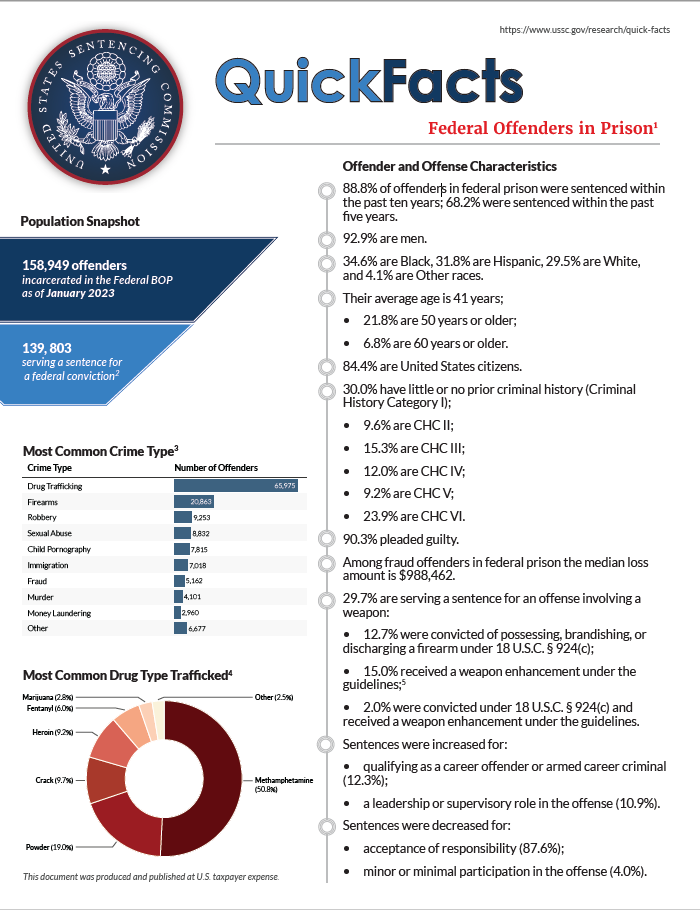As of March 2025, there were 154,155 individuals incarcerated in the Federal Bureau of Prisons. Of these individuals, 134,766 are serving a sentence for a federal conviction.[1], [2], [3]
Click the cover for the PDF handout or learn more below.
Individual and Offense Characteristics
- 88.5% of individuals in federal prison were sentenced within the past ten years; 66.9% were sentenced within the past five years.
- 93.3% are men.
- 34.9% are Black, 30.7% are Hispanic, 29.9% are White, and 4.5% are Other races.
- Their average age is 42 years;
- 22.5% are 50 years or older;
- 7.3% are 60 years or older.
- 85.3% are United States citizens.
- 31.2% have little or no prior criminal history (Criminal History Category I);
- 10.5% are CHC II;
- 14.9% are CHC III;
- 11.1% are CHC IV;
- 9.3% are CHC V;
- 23.0% are CHC VI.
- 90.3% pleaded guilty.
- 31.8% of individuals in federal prison are serving a sentence for an offense involving a weapon:
- 13.3% were convicted of possessing, brandishing, or discharging a firearm under 18 U.S.C. § 924(c);
- 16.5% received a weapon enhancement under the guidelines;[4]
- 2.1% were convicted under 18 U.S.C. § 924(c) and received a weapon enhancement under the guidelines.
- Among individuals sentenced for fraud, the median loss amount was $1,211,500.
- Sentences were increased for:
- qualifying as a "career offender" or armed career criminal (11.0%);
- a leadership or supervisory role in the offense (10.6%).
- Sentences were decreased for:
- acceptance of responsibility (87.7%);
- minor or minimal participation in the offense (3.3%).
Punishment
- The average guideline minimum for individuals in federal prison was 173 months. The average length of imprisonment imposed was 152 months.
- 98.2% were also sentenced to serve a period of supervision after release from prison.
- 61.8% were convicted of an offense carrying a mandatory minimum penalty; of those individuals, 21.1% were relieved of that penalty.
- 1.2% received a sentence reduction under Rule 35(b)— providing substantial assistance after sentencing.
Sentences Relative to the Guideline Range
- 98.3% of sentences for individuals in federal prison were imposed after the United States v. Booker decision, which changed the sentencing guidelines from mandatory to advisory.[5]
- 62.3% of sentences for individuals in federal prison were under the Guidelines Manual:
- 45.1% were sentenced within the guideline range.
- 10.7% were substantial assistance departures.
- The average sentence reduction was 36.5%.
- 1.5% were Early Disposition Program (EDP) departures.[6]
- The average sentence reduction was 41.6%.
- 3.8% were some other downward departure.
- The average sentence reduction was 28.6%.
- 1.2% were upward departures.
- The average sentence increase was 79.0%
- 45.1% were sentenced within the guideline range.
- 37.7% were variances.
- 33.5% were downward variances.
- Their average sentence reduction was 25.9%.
- 4.2% were upward variances.
- Their average sentence increase was 63.0%.
- 33.5% were downward variances.
[1] Individuals in the custody of the Federal Bureau of Prisons as of March 29, 2025.
[2] Commission records could be matched to 133,074 of these individuals and were used for this analysis. Another 19,389 individuals in BOP custody are pre-trial, sentenced in the courts of the District of Columbia, or military.
[3] Cases with incomplete sentencing information were excluded from the analysis.
[4] See e.g., USSG §2D1.1(b)(1). This enhancement applies if the weapon is present, unless it is clearly improbable that the weapon was connected to the offense. The government is not required to prove that the individual personally possessed the weapon.
[5] United States v. Booker, 543 U.S. 220 (2005) was decided on January 12, 2005.
[6] "Early Disposition Program" (or EDP) departures are departures where the government sought a sentence below the guideline range because the defendant participated in the government's Early Disposition Program, through which cases are resolved in an expedited manner.
SOURCE: U.S. Sentencing Commission, FY 1991 through FY 2024 Datafiles, USSCFY91-USSCFY24, and Preliminary Data from FY 2025, USSCFY25.

